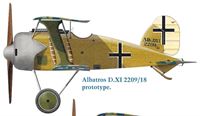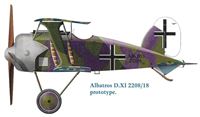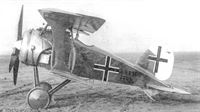
Описание
Страна: Германия
Год: 1918
Fighter
O.Thetford, P.Gray German Aircraft of the First World War (Putnam)
Albatros D XI
The D XI was the first of the Albatros D type lineage to use a rotary engine, and was fitted with the powerful geared Siemens-Halske Sh III of 160 h.p. This engine was installed in a horse-shoe cowling with pointed "elephant-ear" extensions to the rear. These acted as venturi and assisted cooling by sucking air through the cowling, which action also reduced drag.
Two prototypes were built, the first with a four-blade airscrew and balanced ailerons of parallel chord, and the second machine with unbalanced ailerons of inverse taper and a two-blade propeller. Hollow wooden I struts braced the wings. Flying and landing loads were taken by two hollow diagonal struts, which dispensed with need for wire bracing. Both aircraft featured plywood box-type fuselage with built-in fin, the remainder of the aircraft being fabric covered.
Initially flown in February 1918, the D XIs participated in the second D type competition. Remarkable climb performances were established, but no production order was given. Span, 8.0 m. (26 ft. 3 in.). Length, 5.58 m. (18 ft. 3 3/4 in.). Height, 2.86 m. (9 ft. 4 5/8 in.). Area, 18.5 sq.m. (199.8 sq.ft.). Weights: Empty, 494 kg. (1,087 lb.). Loaded, 689 kg. (1,516 lb). Speed, 190 km.hr. (118.75 m.p.h.). Climb (D Comp. at loaded weight of 723 kg.), 15,000 m. (16,400 ft.) in 151 min. Duration, 1.5 hr. Armament, twin Spandau machine-guns.
Описание:
- O.Thetford, P.Gray German Aircraft of the First World War (Putnam)
- W.Green, G.Swanborough The Complete Book of Fighters
- Jane's All The World Aircraft 1919
- J.Herris Albatros Aircraft of WWI. Vol.4: Fighters (A Centennial Perspective on Great War Airplanes 27)
Фотографии
-
J.Herris - Albatros Aircraft of WWI. Volume 4: Fighters /Centennial Perspective/ (27)
Albatros D.XI 2209/18 prototype.
-
J.Herris - Albatros Aircraft of WWI. Volume 4: Fighters /Centennial Perspective/ (27)
Albatros D.XI 2208/18 prototype.
-
J.Herris - Albatros Aircraft of WWI. Volume 4: Fighters /Centennial Perspective/ (27)
The Albatros D.XI 2209/18; slow aileron response resulted in the second D.XI prototype, 2208/18, being fitted with horn-balanced ailerons. Struts were used to brace the wings against flight loads instead of the usual wires.
-
J.Herris - Albatros Aircraft of WWI. Volume 4: Fighters /Centennial Perspective/ (27)
The initial configuration of the Albatros D.XI 2209/18, one of the competitors in the Second Fighter Competition, is shown here. Power was from a Siemens-Halske Sh.III counter-rotary engine, the D.XI being the only Albatros fighter powered by a rotary. Despite being flown by Albatros factory test pilot Henkel, this aircraft flipped over on landing at the competition after one mediocre altitude climb on June 10, 1918. The tall undercarriage legs needed for clearance for the large, two-bladed propeller made the airplane difficult to land safely.
-
Jane's All The World Aircraft 1919 /Jane's/
The Albatross D.XI, flown in 1918 but not put into production.
-
J.Herris - Albatros Aircraft of WWI. Volume 4: Fighters /Centennial Perspective/ (27)
Considered an 'interesting type' Albatros D.XI 2208/18 was included in the Third Fighter Competition despite being powered by a Siemens-Halske rotary. The shorter undercarriage legs allowed by the four-blade propeller made this aircraft easier to land than Albatros D.XI 2209/18. Despite addition of horn-balanced ailerons on 2208/18, the roll rate was still too low for a successful fighter. A likely contributor was the close proximity of the wings spars needed for the I-struts. This reduced the torsional stiffness of the wing, causing it to twist in the direction opposite of aileron application, reducing aileron effectiveness and thence the roll rate. (Peter M. Grosz Collection, SDTB)
-
J.Herris - Albatros Aircraft of WWI. Volume 4: Fighters /Centennial Perspective/ (27)
Considered an 'interesting type' Albatros D.XI 2208/18 was included in the Third Fighter Competition despite being powered by a Siemens-Halske rotary. The shorter undercarriage legs allowed by the four-blade propeller made this aircraft easier to land than Albatros D.XI 2209/18. The D.XI prototypes were very compact, but the roll rate was too low for a successful fighter, likely due to the close proximity of the wings spars needed for the I-struts. This would reduce the torsional stiffness of the wing, causing it to twist in the opposite direction of aileron application.
-
J.Herris - Albatros Aircraft of WWI. Volume 4: Fighters /Centennial Perspective/ (27)
Despite good flying qualities demonstrated at the Third Fighter Competition the Albatros D.XI 2208/18 had a roll rate that was too slow, a critical liability in a fighter, and superior fighters were available.
-
W.Green, G.Swanborough - The Complete Book of Fighters
First rotary-engined Albatros, the D XI.
-
J.Herris - Albatros Aircraft of WWI. Volume 4: Fighters /Centennial Perspective/ (27)
Albatros D.XI 2208/18
-
J.Herris - Albatros Aircraft of WWI. Volume 4: Fighters /Centennial Perspective/ (27)
Albatros D.XI 2209/18














